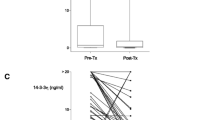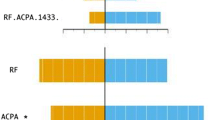Abstract
Background
RA is a systemic inflammatory condition characterized by chronic arthritis and often associated with irreversible joint damage.
Objectives
To assess the significance of serum level of 14-3-3η in RA and its association with clinical and serological features of the disease.
Methods
This is a case-control study done on 80 participants. They were divided into 2 groups. Group 1: 40 rheumatoid arthritis patients compared to group 2: 40 healthy participants matched for age and sex. Laboratory investigations including complete blood count (CBC), erythrocyte sedimentation rate (ESR), C-reactive protein (CRP) rheumatoid factor (RF), anti-citrullinated peptide antibodies (ACPAs), and serum 14-3-3η were done to all participants. Radiological examination in the form of plain X-ray for hands and feet was done to all patients.
Results
Serum levels of 14-3-3η were significantly higher in RA patients compared to the control group (p < 0.001). Serum 14-3-3η was the only predictor of high Larsen’s score (p = 0.013) on using linear regression analysis. Serum 14-3-3η can predict RA in healthy controls in univariate (p = 0.001) and multivariate (p = 0.004) analyses. The receiver operating characteristic (ROC) curve of 14-3-3η was constructed for discrimination between RA and control subjects. The best cut-off value was 61.9 ng/mL, with fair AUC (0.773, p < 0.001), 95% CI (0.656–0.889), and the sensitivity and specificity of 14-3-3η for RA diagnosis as 65% and 95% respectively. Also, we constructed ROC curves for RF, ACPA, 14-3-3η, and their combinations; we found that the highest test sensitivity of 95.7% appeared on adding the 3 markers together, and the highest test specificity of 100% was detected on adding RF to ACPA, 14-3-3η to ACPA or the 3 molecules together.
Conclusion
14-3-3η could be a valuable marker for the diagnosis of RA patients and it may have prognostic value.
Key Points • 14–3-3η is a valuable marker for the diagnosis of RA patients. • 14–3-3η reflects disease severity and joint damage in RA patients. |


Similar content being viewed by others
References
Taylor P, Moore A, Vasilescu R et al (2016) A structured literature review of the burden of illness and unmet needs in patients with rheumatoid arthritis: a current perspective. Rheumatol Int 36(5):685–695
Englbrecht M, Kruckow M, Araujo E, Rech J, Schett G (2013) The interaction of physical function and emotional well-being in rheumatoid arthritis—what is the impact on disease activity and coping? Semin Arthritis Rheum 42(5):482–491
Gizinski A, Fox D (2014) T cell subsets and their role in the pathogenesis of rheumatic disease. Curr Opin Rheumatol 26(2):204–210
Pratesi F, Migliorini P (2014) Something old, something new: biomarkers in rheumatoid arthritis. J Rheumatol 41(11):2091–2093
Trouw L, Mahler M (2012) Closing the serological gap: promising novel biomarkers for the early diagnosis of rheumatoid arthritis. Autoimmun Rev 12(2):318–322
Johnson C, Crowther S, Stafford M et al (2010) Bioinformatic and experimental survey of 14-3-3-binding sites. Biochem J 427(1):69–78
Gardino A, Smerdon S, Yaffe M (2006) Structural determinants of 14-3-3 binding specificities and regulation of subcellular localization of 14-3-3-ligand complexes: a comparison of the X-ray crystal structures of all human 14-3-3 isoforms. Semin Cancer Biol 16(3):173–182
Marotta A, van Kuijk W, Maksymowych W et al (2012) 14–3–3 Eta is a modifiable serum biomarker that marks adalimumab response in psoriatic arthritis. Arthritis Rheum 64:S247–S247
Maksymowych W, Wichuk S, Lambert R et al (2014) Autoantibodies to 14-3-3η are novel biomarkers associated with inflammation and radiographic progression in ankylosing spondylitis. Arthritis Rheumatol 66:S1305
Maksymowych W, Marotta A (2014) 14-3-3η: a novel biomarker platform for rheumatoid arthritis. Clin Exp Rheumatol 32(85):S35–S39
Maksymowych W, Naides S, Bykerk V et al (2014) Serum 14-3-3 is a novel marker that complements current serological measurements to enhance detection of patients with rheumatoid arthritis. J Rheumatol 41(11):2104–2113
Aletaha D, Neogi T, Silman A et al (2010) 2010 rheumatoid arthritis classification criteria: an American College of Rheumatology/European League Against Rheumatism collaborative initiative. Arthritis Rheum 62(9):2569–2581
Prevoo M, Van'T Hof M, Kuper H et al (1995) Modified disease activity scores that include twenty-eight-joint counts development and validation in a prospective longitudinal study of patients with rheumatoid arthritis. Arthritis Rheum 38(1):44–48
Fransen J, Creemers M, Van Riel P (2004) Remission in rheumatoid arthritis: agreement of the disease activity score (DAS28) with the ARA preliminary remission criteria. Rheumatology 43(10):1252–1255
Bardwell W, Nicassio P, Weisman M et al (2002) Rheumatoid arthritis severity scale: a brief, physician-completed scale not confounded by patient self report of psychological functioning. Rheumatology 41(1):38–45
Bruce B, Fries J (2004) Longitudinal comparison of the Health Assessment Questionnaire (HAQ) and the Western Ontario and McMaster Universities Osteoarthritis Index (WOMAC). Arthritis Rheum 51(5):730–737
Rau R, Herborn G (1995) A modified version of Larsen’s scoring method to assess radiologic changes in rheumatoid arthritis. J Rheumatol 22(10):1976–1982
Singer J, Plotz C (1956) The latex fixation test. Am J Med 21(6):888–892
Pruijn GJ, Wiik A, van Venrooij W (2010) The use of citrullinated peptides and proteins for the diagnosis of rheumatoid arthritis. Arthritis Res Ther 12(1):1–8
Kilani R, Maksymowych W, Aitken A, Boire G, St-Pierre Y, Li Y, Ghahary A (2007) Detection of high levels of 2 specific isoforms of 14-3-3 proteins in synovial fluid from patients with joint inflammation. J Rheumatol 34(8):1650–1657
Hitchon C, Smolik I, Meng X et al (2015) Serum 14-3-3eta are elevated in indigenous North Americans with rheumatoid arthritis and may predict imminent synovitis in their at-risk first degree relatives. Arthritis Rheumatol 67:3723–3724
Carrier N, Marotta A, De Brum-Fernandes A et al (2016) Serum levels of 14-3-3η protein supplement C-reactive protein and rheumatoid arthritis-associated antibodies to predict clinical and radiographic outcomes in a prospective cohort of patients with recent-onset inflammatory polyarthritis. Arthritis Res Ther 18(1):1–14
Thery C, Boussac M, Veron P et al (2001) Proteomic analysis of dendritic cell-derived exosomes: a secreted subcellular compartment distinct from apoptotic vesicles. J Immunol 166(12):7309–7318
Maksymowych W, Landewe R, Tak P et al (2009) Reappraisal of OMERACT 8 draft validation criteria for a soluble biomarker reflecting structural damage endpoints in rheumatoid arthritis, psoriatic arthritis, and spondyloarthritis: the OMERACT 9 v2 criteria. J Rheumatol 36(8):1785–1791
Hirata S, Marotta A, Gui Y et al (2015) Serum 14-3-3η level is associated with severity and clinical outcomes of rheumatoid arthritis, and its pretreatment level is predictive of DAS28 remission with tocilizumab. Arthritis Res Ther 17(1):1–10
Naides S, Marotta A (2015) 14-3-3 in “seronegative” rheumatoid arthritis. J Rheumatol 42(10):1995–1995
Van Beers-Tas M, Marotta A, Boers M et al (2016) A prospective cohort study of 14-3-3η in ACPA and/or RF-positive patients with arthralgia. Arthritis Res Ther 18(1):1–7
Hammam N, Salah S, Kholef EF, Moussa EM, Marotta A (2020) 14-3-3η Protein in serum and synovial fluid correlates with radiographic damage and progression in a longitudinal evaluation of patients with established rheumatoid arthritis. Mod Rheumatol 30(4):664–670
Guan SZ, Yang YQ, Bai X, Wang Y, Feng KQ, Zhang HJ et al (2019) Serum 14-3-3η could improve the diagnostic rate of rheumatoid arthritis and correlates to disease activity. Ann Clin Lab Sci 49(1):57–62
Zhang Y, Liang Y, Feng L, Cui L (2020) Diagnostic performance of 14-3-3η and anti-carbamylated protein antibodies in rheumatoid arthritis in Han population of Northern China. Clin Chim Acta 502:102–110
Vasconcellos A, Chittalae S, Efthimiou P (2015) Does 14-3-3 Eta protein offer any additional diagnostic value in rheumatoid arthritis? Arthritis Rheumatol 67:3169–3170
Author information
Authors and Affiliations
Corresponding author
Ethics declarations
Disclosures
None.
Additional information
Publisher’s note
Springer Nature remains neutral with regard to jurisdictional claims in published maps and institutional affiliations.
Rights and permissions
About this article
Cite this article
Hussin, D.A.A.H., Shaat, R.M., Metwally, S.S. et al. The significance of serum 14-3-3η level in rheumatoid arthritis patients. Clin Rheumatol 40, 2193–2202 (2021). https://doi.org/10.1007/s10067-020-05524-3
Received:
Revised:
Accepted:
Published:
Issue Date:
DOI: https://doi.org/10.1007/s10067-020-05524-3




